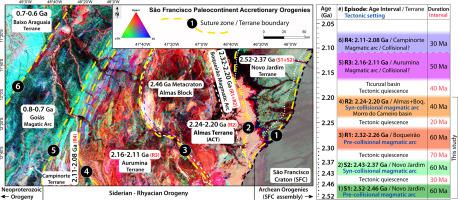当前位置:
X-MOL 学术
›
Gondwana Res.
›
论文详情
Our official English website, www.x-mol.net, welcomes your
feedback! (Note: you will need to create a separate account there.)
Multi-stage crustal accretion by magmatic flare-up and quiescence intervals in the western margin of the São Francisco Craton: U-Pb-Hf and geochemical constraints from the Almas Terrane
Gondwana Research ( IF 7.2 ) Pub Date : 2020-09-01 , DOI: 10.1016/j.gr.2020.04.005 Marco Antonio Caçador Martins-Ferreira , Airton Natanael Coelho Dias , Farid Chemale , José Eloi Guimarães Campos , Marina Seraine , Eduardo Novais-Rodrigues
Gondwana Research ( IF 7.2 ) Pub Date : 2020-09-01 , DOI: 10.1016/j.gr.2020.04.005 Marco Antonio Caçador Martins-Ferreira , Airton Natanael Coelho Dias , Farid Chemale , José Eloi Guimarães Campos , Marina Seraine , Eduardo Novais-Rodrigues

|
Abstract The global plate tectonic regime in early Paleoproterozoic times is highly debated. The interval 2.45–2.2 Ga is known for a minima in juvenile magmatism, but this is not a global phenomenon. New results of whole-rock geochemistry and U–Pb-Hf analysis in igneous and detrital zircons, allied with existing isotopic and geophysical data, allow to identify and constrain the duration of magmatic flare-up and quiescence events in the western Sao Francisco Paleoplate. Igneous samples yield ages indicating three accretionary magmatic events, an older with ages ca. 2476.4 ± 9 Ma to 2462 ± 13 Ma, an intermediate at 2390 ± 14 Ma, and a younger from 2235 ± 26 Ma to 2201 ± 5 Ma, all presenting magmatic arc geochemical signatures. Xenoliths of quartzite and volcanic tuff from the upper greenstone sequence (Morro do Carneiro Fm.) are hosted in the 2211 ± 9 Ma tonalite and the maximum depositional age of the Morro do Carneiro basin is dated 2234 ± 12 Ma, indicating a syn-orogenic setting for this basin. Detrital zircon U Pb age distribution for quartzites of the greenstone sequence shows peaks at 2.65, 2.47, 2.39, 2.27 and 2.23 Ga. Altogether, the studied rocks record an accretionary orogeny with four distinct episodes: Episode S1: 2.52–2.46 Ga, ɛHf(t) values from +0.57 to +6.36; Episode S2: 2.43–2.37 Ga, ɛHf(t) values from +0.10 to +4.30; Episode R1: 2.32–2.26 Ga, ɛHf(t) values from +1.61 to −7.23 (from detrital zircons); Episode R2: 2.24–2.20 Ga, ɛHf(t) values from +0.39 to −2.73. These early Paleoproterozoic accretionary orogenies mark the onset of amalgamation of the Sao Francisco continental paleoplate that surrounds the craton, with accretions of an exotic micro-block and continental magmatic arcs, indicating evolution from dominant Siderian juvenile magmatism to Rhyacian crustal magmatism. These patterns show striking similarities to the orogenies in the Mineiro Belt and North China Craton.
中文翻译:

圣弗朗西斯科克拉通西缘岩浆爆发和静止区间的多阶段地壳增生:来自阿尔马斯地体的 U-Pb-Hf 和地球化学约束
摘要 古元古代早期的全球板块构造体制引起了高度争议。2.45-2.2 Ga 区间以幼年岩浆活动的最小值而闻名,但这不是全球现象。火成岩和碎屑锆石的全岩地球化学和 U-Pb-Hf 分析的新结果,结合现有的同位素和地球物理数据,可以识别和限制圣弗朗西斯科古板块西部岩浆爆发和静止事件的持续时间。火成岩样品产生的年龄表明三个增生岩浆事件,一个年龄大约为 2476.4±9 Ma~2462±13 Ma,2390±14 Ma中间,2235±26 Ma~2201±5 Ma,均呈现岩浆弧地球化学特征。来自上绿岩层序的石英岩和火山凝灰岩捕虏体 (Morro do Carneiro Fm. ) 位于 2211 ± 9 Ma 灰岩中,Morro do Carneiro 盆地的最大沉积年龄为 2234 ± 12 Ma,表明该盆地属于同造山环境。绿岩层序石英岩的碎屑锆石 U Pb 年龄分布在 2.65、2.47、2.39、2.27 和 2.23 Ga 处出现峰值。总的来说,研究的岩石记录了具有四个不同阶段的增生造山作用:第 S1 集:2.52-2.46 Ga(ɛHf(ɛHf)) t) 从 +0.57 到 +6.36 的值;第 S2 集:2.43–2.37 Ga,ɛHf(t) 值从 +0.10 到 +4.30;第 R1 集:2.32–2.26 Ga,ɛHf(t) 值从 +1.61 到 -7.23(来自碎屑锆石);第 R2 集:2.24–2.20 Ga,ɛHf(t) 值从 +0.39 到 -2.73。这些早期的古元古代增生造山运动标志着围绕克拉通的圣弗朗西斯科大陆古板块合并的开始,伴随着奇异微块和大陆岩浆弧的增生,表明从占主导地位的 Siderian 幼年岩浆作用到 Rhyacian 地壳岩浆作用的演化。这些模式与米内罗带和华北克拉通的造山运动有着惊人的相似之处。
更新日期:2020-09-01
中文翻译:

圣弗朗西斯科克拉通西缘岩浆爆发和静止区间的多阶段地壳增生:来自阿尔马斯地体的 U-Pb-Hf 和地球化学约束
摘要 古元古代早期的全球板块构造体制引起了高度争议。2.45-2.2 Ga 区间以幼年岩浆活动的最小值而闻名,但这不是全球现象。火成岩和碎屑锆石的全岩地球化学和 U-Pb-Hf 分析的新结果,结合现有的同位素和地球物理数据,可以识别和限制圣弗朗西斯科古板块西部岩浆爆发和静止事件的持续时间。火成岩样品产生的年龄表明三个增生岩浆事件,一个年龄大约为 2476.4±9 Ma~2462±13 Ma,2390±14 Ma中间,2235±26 Ma~2201±5 Ma,均呈现岩浆弧地球化学特征。来自上绿岩层序的石英岩和火山凝灰岩捕虏体 (Morro do Carneiro Fm. ) 位于 2211 ± 9 Ma 灰岩中,Morro do Carneiro 盆地的最大沉积年龄为 2234 ± 12 Ma,表明该盆地属于同造山环境。绿岩层序石英岩的碎屑锆石 U Pb 年龄分布在 2.65、2.47、2.39、2.27 和 2.23 Ga 处出现峰值。总的来说,研究的岩石记录了具有四个不同阶段的增生造山作用:第 S1 集:2.52-2.46 Ga(ɛHf(ɛHf)) t) 从 +0.57 到 +6.36 的值;第 S2 集:2.43–2.37 Ga,ɛHf(t) 值从 +0.10 到 +4.30;第 R1 集:2.32–2.26 Ga,ɛHf(t) 值从 +1.61 到 -7.23(来自碎屑锆石);第 R2 集:2.24–2.20 Ga,ɛHf(t) 值从 +0.39 到 -2.73。这些早期的古元古代增生造山运动标志着围绕克拉通的圣弗朗西斯科大陆古板块合并的开始,伴随着奇异微块和大陆岩浆弧的增生,表明从占主导地位的 Siderian 幼年岩浆作用到 Rhyacian 地壳岩浆作用的演化。这些模式与米内罗带和华北克拉通的造山运动有着惊人的相似之处。











































 京公网安备 11010802027423号
京公网安备 11010802027423号